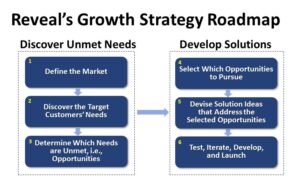The 3 Keys to Win at Innovation
In their excellent book, “The 4 Disciplines of Execution,” (4DX) authors Chesney, Covey, and Huling explain how companies can consistently achieve their Wildly Important Goals (WIGs) in the midst of the “whirlwind” of day-to-day operations.
WIGs are those important, non-urgent goals that are easily ignored because of the relentless pressure to address day-to-day operations. Not achieving a WIG can have devastating consequences, however, for everyone involved including the team, the company, and its customers. The difference between companies that achieve their WIGs and those that do not is a good execution plan.
Part of a good execution plan is learning how to identify lead and lag measures of success.
• A lag measure tells you if you’ve achieved the goal (e.g., generate revenue of least $X in the second quarter) while a lead measure tells you if you are likely to achieve the goal (e.g., every sales person makes at least 20 calls to prospective customers)
• A lag measure is hard to act on while a lead measure is within your control
• The key to success in achieving a WIG is to focus on the most important lead measures
Companies fail to achieve their WIGs because they fail to identify and execute on their key lead measures. Until the key lead measures are identified and executed, employees will spend their time on activities that don’t deliver results. Great insights!
But these insights are not just for business in general. They’re for innovation and growth strategy as well. Isn’t innovation a WIG that many companies fail to achieve because they don’t have a reliable innovation execution plan and have not identified the key lead measures that can predictably deliver results?
Here’s our front end of innovation execution process that enables companies to consistently generate winning new or improved offerings:

These six steps can also be understood as an “organizational job map” for executing the job of “creating unique value for target customers.” They the steps that an organization must take to consistently deliver results. I think of the steps as a sequence of lead measures. That is, if you execute these steps, you will consistently create unique value for your target customers.
Because study after study has shown that the #1 reason for new product failure is misunderstanding the customers’ needs, I would say that the #1 and #2 lead measures for innovation success that most companies don’t do effectively are to identify and prioritize the target customers’ unmet needs. The key to success here is to know what type of customer “needs” to obtain, how to get them, and how to use them. If you don’t get the right customer inputs upfront, and prioritize them, then you’re likely to make things customers don’t want. As the adage goes, “garbage in, garbage out.”
As I attempt to integrate the principles of 4DX with Jobs-to-Be-Done (JTBD), I see 3 keys for winning at innovation:
1. Establish a reliable innovation execution process that consistently delivers results
2. Identify the lead measures and execute them in sequence
3. Because the chief objective of innovation is to create unique value for your target customers, hire of gain the skills necessary to identify and prioritize the target customers’ unmet needs
It’s interesting to note that the late Harvard Business School Professor, Clayton Christensen, who was a pioneer of the Jobs-to-Be-Done innovation approach, wrote the forward to “The 4 Disciplines of Execution.” In that forward, he wrote “the book truly contains a theory of causality of ‘how’ effective execution is achieved.”
Anyone who has read Christensen’s writings knows that he was a big advocate of Jobs Theory because it, too, is a theory of causality but, in this case, a theory about how to successfully create new and improved offerings that customers want. Christensen devoted his career to explaining “what causes what to happen.” Both the 4 Disciplines of Execution and Jobs-to-Be-Done were special to him precisely because they are both theories of causality. They both explain how to get results in a reliable manner.
“I’ve spent twenty years gathering evidence so that you can put your time, energy, and resources into creating products and services that you can predict, in advance, customers will be eager to hire. Leave relying on luck to the other guy.”
– Clayton M. Christensen et al, Competing Against Luck: The Story of Innovation and Customer Choice, p. 232.




